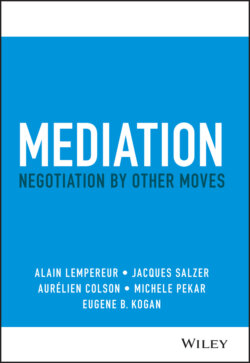Читать книгу Mediation - Alain Lempereur - Страница 46
The supplier, their client, and the implementation of a contract
ОглавлениеIn this conflict, Client A considers the rule of law to be the uppermost consideration; on the other hand, their Supplier B emphasizes the lack of information, non‐compliant work techniques, and personal attacks. In the dialogue, each person repeats the important points for themselves, while carefully avoiding addressing those of the other.
PERSON A: Article 42 of that regulation provides, in case of transportation, that the manufacturer is liable.
PERSON B: But you did not give us any information about the quality of …
1 A: Anyway, six years ago, you gave us a hard time about … We did not come to terms with it.
2 B: What are you talking about? Are you the one complaining? Did you see how you received our representatives? You called them every name under the sun!
3 A: At our company, we favor directness. When we have something to say, we are frank about it.
4 B: But the delivered products were rigorously compliant with the contract.
5 A: I have already told you that Article 42 … provides that the manufacturer is liable.
A and B end up repeating themselves, and the dialogue goes around in circles (also see Chapter 6).
Anyone can observe these parallel “monologues” in conflict situations, both in negotiations and in court proceedings. It aims only to present to the other side the arguments that affect us, without responding to those put forward by the other side. It is a stubborn repetition of the same words, without going into detail or explaining each of the points that are important to the other. This “non‐dialogue” evokes a reciprocal avoidance that fails to deal with the problems of the other party. On the other hand, thanks to mediation, dialogue orchestrated by a third party – the “trilogue” or “trialogue” – brings the problems perceived by one and by the other into the exchange. In mediation, increasing importance is given to recognition of the essential role of the mediator as the organizer of the meetings (Lempereur 2015c), orchestrating a sequence where a typical agenda includes both parties' priorities. During this process, the mediator enforces the agenda and helps to clarify different points and how they are connected, so that each party successively goes after important points for oneself and for the other.
In the previous example, mediators devoted a time slot for speaking when the parties could successively explain themselves on the following:
For A:
The application of Article 42
Traces of old disputes (“Six years ago …”)
For B:
The reality of the lack of information
The greetings of representatives perceived as insulting
The compliance verification of the delivered products
From there, and subject to good faith in the statement of concerns by each person, the mediator invites each party to integrate what poses a problem for the other. This reciprocal recognition, by accepting possible disagreements on the interpretation of the facts, contributes to the emergence of potential solutions to the problems invoked by each party.
In addition to this juxtaposition of priorities, another source of complexity is that mediation succeeds in managing the existence of many intertwined, independent, but linked conflicts. What appeared to be one conflict, is, in reality, many underlying conflicts. In court, where a conflict hides other ones, judges find themselves quickly annoyed: solicited for a particular dispute, they cannot rule on another one, even if it is linked to the first one. Mediators, on the other hand, embrace the complexity of the diverse elements of the conflict.
